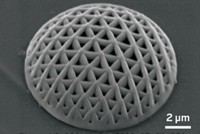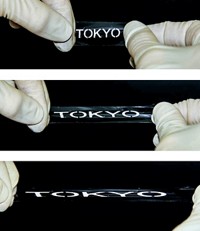Advertisement
Grab your lab coat. Let's get started
Welcome!
Welcome!
Create an account below to get 6 C&EN articles per month, receive newsletters and more - all free.
It seems this is your first time logging in online. Please enter the following information to continue.
As an ACS member you automatically get access to this site. All we need is few more details to create your reading experience.
Not you? Sign in with a different account.
Not you? Sign in with a different account.
ERROR 1
ERROR 1
ERROR 2
ERROR 2
ERROR 2
ERROR 2
ERROR 2
Password and Confirm password must match.
If you have an ACS member number, please enter it here so we can link this account to your membership. (optional)
ERROR 2
ACS values your privacy. By submitting your information, you are gaining access to C&EN and subscribing to our weekly newsletter. We use the information you provide to make your reading experience better, and we will never sell your data to third party members.
Materials
Teflon-Patterned Paper
Peptide Synthesis: Nonstick barriers help build arrays for screening
by Carmen Drahl
April 18, 2014
| A version of this story appeared in
Volume 92, Issue 16
Most chemical reactions perform best when shaken or stirred. Active mixing maximizes the chances that reactant molecules will find one another. But chemists who are exploiting small-volume reactions on paper, which is a low-cost platform for synthesis and screening, rarely achieve such thorough mixing.
A team in Canada now suggests a solution for that issue: printing Teflon barriers onto paper (Angew. Chem. Int. Ed. 2014, DOI: 10.1002/anie.201402037). The barriers direct where excess solvent seeps through, promoting mixing. The researchers, led by Ratmir Derda of the University of Alberta, used the technique to build 96 small peptides side by side on a sheet of paper about the size of an index card.
Printing barriers on paper isn’t a new idea, and researchers have used specially treated liquid-repelling paper before. But combining the barrier and liquid-repulsion concepts provides an improvement over established techniques, says Marya Lieberman, who builds paper analytical devices at the University of Notre Dame. Solvents dissolve the wax barriers often used, and other methods require specialized facilities. Derda’s Teflon technique, in contrast, uses a printer and simple solution processing to form solvent-resistant barriers that make the paper compatible with a wider range of chemistry, she says.
Though the peptide yields are not significantly better than those of established solid-phase peptide synthesis techniques, the work is a step forward in streamlining such syntheses, says Helen E. Blackwell, an expert in paper arrays at the University of Wisconsin, Madison. Derda’s paper supports can be stacked as reagents are loaded and excesses are washed away. This “very clever strategy” may eventually facilitate interesting combinatorial chemistry, Blackwell says.
Derda has filed a provisional patent on the technology.






Join the conversation
Contact the reporter
Submit a Letter to the Editor for publication
Engage with us on Twitter